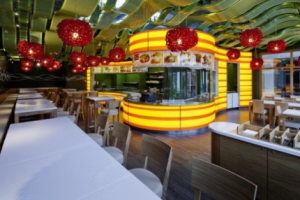
Aluminium perforated sheets in the Arabica perforation from the MEVACO Creative Line create the illusion of a sea on the ceiling in the Asia Cocos bistro in the Designer Outlet Center in Parndorf, Austria.
Günter Plattl of the company Alu Hofstätter in Rohrbach, Austria constructed the sophisticated curved panels under the guidance of the Hamburg architects Ralf Kürbitz and Kerstin Heyroth. The most beautiful interplays between light and shadow arise together with the LED lamps.
To distinguish itself from the mass of franchise restaurants with edgy architectural ideas is the declared aim of the Cocos restaurants. The emphasis is on individually designed restaurants and bistros instead of uniformity. The most recent example is the Asia Cocos bistro in the Designer Outlet Center in Parndorf, Austria where over 170 designer stores offer their goods on a sales area of 37,700 m².
This was a challenge for the architects Ralf Kürbitz and Kerstin Heyroth as, "visitors want something special in a designer outlet," says Ralf Kürbitz. "But they also need an oasis of calm away from the hustle and bustle."
The something special was realised via the illusion of a sea landscape on the ceiling. It is made from MEVACO aluminium perforated sheets in the Arabica perforation from the Creative Line range. To achieve this, the architects calculated three different wave amplitudes in different widths. The task of incorporating this undulating shape into the perforated sheets fell to Günter Plattl and his company Alu Hofstätter in Rohrbach, Austria.
He constructed curved panels out of the MEVACO perforated sheets with the corresponding wavelike form. These were welded on to frames and mounted on the ceiling. "The perforated sheet waves thus allow for beautiful light effects," says Ralf Kürbitz.
"These are generated by the LED lamps. Because there are some areas, which catch the light better than others and others that are accordingly more in the dark, the guests can always discover new interplays between light and shadow."
For the Hamburg architects, it also comes down to, "being able to implement creative ideas". This requires know-how and good cooperation. Something that they viewed very positively here: "This was no problem at all for us thanks to the good cooperation with MEVACO and Alu Hofstätter."
